(Continued from Part – 2)
Part – 3
(Renaissance Period, 1453 – 1600)
(In our country, the timeline corresponds to the Lodhi reign at Delhi to it’s fall at the advent of Moughal empire, till the time of Akbar)
In earlier parts, we have dwelt upon the progress made since Middle Ages till the arrival of Renaissance Period (broadly till 1453) in matter decoding the mystery of electricity that was hidden in Nature. Science had not progressed by any significant extent during this timeline. However, we may index for some game-changing discoveries from Asia or Arab world which has not got the deserving recognition. Discovery of Zero by Aryabhatta of India in around 550 AD is a case to the point. In Europe, this timeline is stamped as Dark Ages.
The Renaissance Period had awakened the people’s minds with a jerk.Hitherto prevailed practice of keeping God or Religion as central to all human activities had undergone a paradigm shift. The new line of thoughts placed Human as their central axis. Literature was created to glorify the sentiments of human, rather than telling eulogy of Gods. Arts (paintings and sculptures) also started depicting common emotions of Human rather than grand-standing the God’s heavenly images.
Da Vinchi was born in 1452 and was in his creative epoch at the advent of Renaissance. Michelangelo, his 23 years junior and Raphael (Michelangelo’s contemporary) was also creating upheavals in the domain of paintings and sculptures. After 40 years, there will appear Tintoretto whom Satyajit Ray has made famous in his Bangla story Tintoretto’s Jesus. The story wad made into a movie where one charactar is explaining about Giotto, who about 100 years ago, had broken the then-prevailing Byzantine style of painting and introduced a 3 dimensional style that would remain as a signature for Renaissance style.
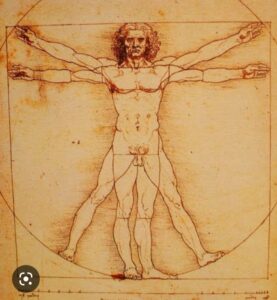
Vitruvian Man by Da Vinchi

Pieta by Michelangelo
Apart from the sphere of Art, the initial Renaissance years have also senn progress in Technologies. There were advancements in mining, metallurgy – blast furnace has arrived, printing press and fire arms have appeared. Nautical Compass for sailors has been developed, nautical astrolabe has come into use. Engineering drawings for designs have introduced. But all these have no link with Electricity.

Nautical Astrolabe
On experiments which will later help to decode Electricity, the name in forefront is of William Gilbert (1544 – 1602). That was contemporary of Mughol emperor Akbar in India (1542 ” 2603). He was from England, obtained his degree in medicine from Cambridge and spent his life at London, practicing medicine. He later became FRCP and was a doctor for Queen Elizabeth. Along with his medical profession, he experimented on many scientific subjects.
Nearly on the year Gilbert was born, Copernicus, the famous astronomer from Prussia (today’s Poland), in 1543, had proposed a revolutionary new theory of rotation of celestial bodies – Heliocentric Theory. In those times it was believed that Earth is stationary and is at the center of celestial bodies. The sky around earth is rotating, taking Sun, Moon, Planets and Stars in it. That is why we see them regularly appearing and disappearing every day. This concept was near to man’s immediate senses, hence easy to comprehend. This was also in line with the biblical gospels and so was supported by Church.
But Copernicus first contradicted to this belief. Based on his naked-eye observations of sky (celestial bodies) over long years (telescope was not invented then) and drawing from the inferences of the previous Arab scholars on astronomy, he hypothesied that a) Earth is not stationary, it is rotating, b) Earth is not at the center of the rotation of celestial bodies but Sun is, c) Celestial bodies are rotating around the Sun in their own orbits. In a nutshell, this is the gist of his new Heliocentric theory. But though Copernicus had arrived at his postulates 25 years ago, he did nor air it in fear of confrontation with the Church. He could only publish it in 1543 when he was of 70 years and at his death bed. We can now understand his fear by judging from the fact that within 50 years, in 1600, Giordano Bruno was burnt alive on stake in Florence under Inquisition by Church for harbouring a contrary view from the Church.

Copernicus
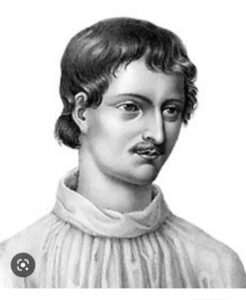
Giordano Bruno
Such weird looking hypothesis was not accepted by common public. The ground on which we are standing is rotating ? Pretty difficult to comprehend that. So the new hypothesis didn’t get many takers. (Even 40 years later when Galileo died in 1642, he was a captive loner with this heliocentric theory)
Gilbert was born in 1544, one year after the new heliocentric theory had appeared. He read about it as he grew up. He thought to conduct his own experiment on earth’s rotation. During the course of such experiments, he first posited that Earth itself is a large Magnet which has got huge attraction power like a lodestone. To the Earth’s attractive power, he gave the name “Terelia’. Based on this attractive power of Earth, he suggested some theories on celestial rotations.
Gilbert’s hypothesis that Earth itself is a large magnet (which he proposed while tracing the reasons of earth’s rotation) will later to become an axiom in the path of understanding of today’s electricity.
Apart from earth’s magnetic attractions, Gilbert had also experimented on frictional attraction of amber. Gilbert was the first to give a name to that attractive power – Elektron.. It is a Greek word, meaning – Like amber in it’s attractive properties. From this word coined in 1600, came the word Electricity, first mentioned in 1640 by Thomas Browne, to denote the property of frictional attraction.
Obviously what is meant by Electricity today was leagues behind qn 1640. People then must not had an iota of imagination that the word will explode to such all-encompassing proportions in next 300 years.
Gilbert, on frictional attraction, thought of an unseen ‘Fluid’ present in the body of the object, which on rubbing, creates an ‘effluvium’ surrounding the object, which causes the attraction.
During the time of Gilbert, what was happening in India? Emperor Akbar was ruling the mughol empire from Agra. Todarmal was making a survey map of the terrain of India to streamline mughol tax-collection. Sri Chaitanya Deb had completed his devine lifetime few years ago.

Gilbert

Akbar
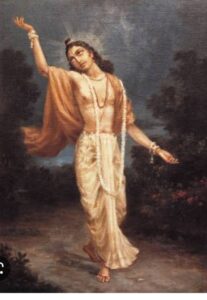
Sri Chaitanya Deb
Next 150 years (1600 – 1757)
(In our country, it was from Jahangir’s time till the time of Battle of Plassey when East India Company had put it’s foothold on India’s soil)
In Europe, this period had witnessed the arrival of galaxy of stars in science horizon. Galileo, in Italy, was at his creative best. He will leave the world in 1642. In next year (1643), another shinning star will be born in England – Issac Newton. He will be later crowned as one of the greatest scientists of the world by another great – Albert Einstein. Newton will give the world the revolutionary Laws of Gravity and Laws of Motion.

Galileo
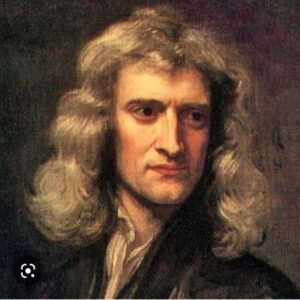
Issac Newton
In 1600, Gilbert first introduced the tem Electricus. From there, in 1646, the word Electricity was first put to use in English language by Thomas Browne (He was an English polymath who had added more than 750 new words in English vocabulary). The word is meant for attractive property of rubbed materials.
In 1672, Otto Von Guericke of Germany experimented on electricity wth a sulpher ball electrostatic generator devise and explored the attractive/repulsive behaviour under various test conditions. He was a prolific experimentalist on many subjects. We all have read in our school books of his famous experiment of Magdeburg spheres to prove air pressure.
He thought of Corporeal and Incorporeal Potencies of bodies. Return of a body thrown upward, back to ground is posited as Incorporeal Potency (action from a distance). That object’s bouncing up again was reasoned as Expulsive Potency. Action and Reaction theory as we know it today (Newton’s Law of Motion, 1687) was not in horizon then. It would appear after 15 years.
Guericke had proposed his reason of Electrical attraction/repulsion phenomena under his Corporeal Potency theory.
Charles Du Fey (1698 – 1739) was born in France to a family with military traditions. He was raised as an ancient Roman – equally for arms and letters. At 14, he joined French army and participated in active war campaign at 20. He left army at 22 and joined as a chemist. For next 19 years till his early death at the age of 41, he worked and experimented on a series of subjects, electricity being one of them.
Till 1730s, electricity was thought merely an object of curiosity Du Fey was one of the pioneer investigator of the electrical phenomenon when no one had any fair idea what electricity was. The best thing people knew that Electricity is a simple property of all solid materials, like ‘ heaviness’.
Du Fey observed, 1n 1733, that attraction from rubbed glass and rubbed amber behaves differently. To support the difference in behavior, he proposed a 2 Fluid theory – Vitreous (glass) and Resinous (amber). In a non-electrified body, 2 fluids are present in equal amount and stands neutralised. Rubbing is assumed to remove one of the fluids, leaving an excess of the other, resulting in electrification (attraction). This is an extension of the ‘effluvium’ theory, as posited by Gilbert some 130 years ago. Today, these are known as +ve charge and -ve charge.
Du Fay used a device called Layden Jar which could store large amount of electricity that can be used later. He used this devise to his experiments. He had also used it for performing some funny demonstrations. In one, he made 180 soldiers to stand in a circle, all joining their hands. He then let the 1st soldier hold the jab and the last one to touch the center wire of a loaded Layden Jar. The discharged electricity had produced a shock through the body of the soldiers and all of them were thrown up in the air, off the ground to great amusement of surrounding viewers. Only they didn’t know that such trick could be deadly.
He had also attempted to measure the force of magnetic poles but could not establish a relation between force and distance. It will take another 50 years when another French scientist Coulomb will define such laws.
In the path of uncovering Electricity, Du Fey had left very bold imprints. His conviction of universal charactar of electricity, his insistence on the importance of the subject, his method of organising and digesting the known facts before grasping for more – all had set order in the study of electricity.
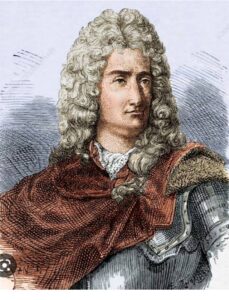
Charles Du Fey, French scientist (1698 -1739)
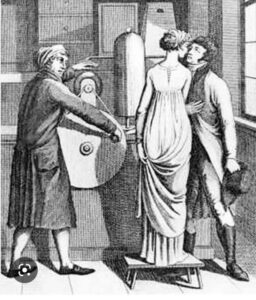
Parlour Fun Machine
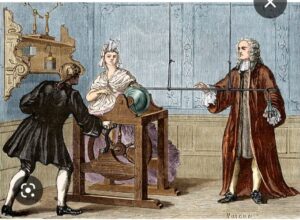
Leyden Jar
In 1752, American experimentalist Benjamin Franklin was able to collect electric charge from lightening o a cloudy day, into a Layden Jar through his famous kite experiment. One year later, in 1753, while attempting for a similar experiment, ,Russian scientist George Wilhelm Richman got electrocuted and lost his life.
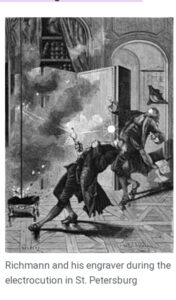
Richman
In contemporary India, there was series of Maratha invasions in Bengal during 1740s. In 1757, Battle of Plassey happened and East India Company set their military foothold on Indian soil.
(To be continued)
